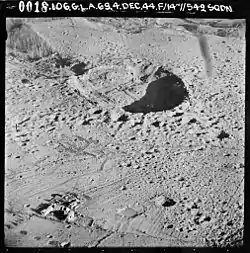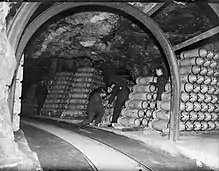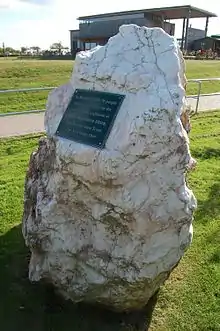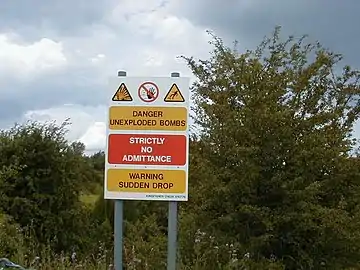RAF Fauld explosion
The RAF Fauld explosion was a military accident which occurred at 11:11 am on Monday, 27 November 1944 at the RAF Fauld underground munitions storage depot in Staffordshire, England. It was one of the largest non-nuclear explosions in history and the largest on UK soil.
| RAF Fauld explosion | |
|---|---|
| Staffordshire, England, UK | |
 Aerial view of the crater and damage to the surrounding area caused by the explosion, taken by the RAF on 4 December 1944 | |
 RAF Fauld explosion Location in Staffordshire | |
| Coordinates | 52°50′50″N 01°43′50″W |
Between 3,500 and 4,000 tonnes (3,900 and 4,400 tons) of ordnance exploded, mostly high explosives. The explosion crater with a depth of 100 feet (30 m) and 250 yards (230 m) across is still visible just south of Fauld, to the east of Hanbury, Staffordshire. It is now known as the Hanbury Crater.[1][2][3]
A nearby reservoir containing 450,000 cubic metres (16,000,000 cu ft) of water was obliterated in the incident, along with several buildings including a complete farm. Flooding caused by the destruction of the reservoir added to the damage directly caused by the explosion.[4]
The exact death toll is uncertain; it is believed that about 70 people died in the explosion and the resulting flood.[3]
Cause

The cause of the disaster was not made clear at the time. There had been staff shortages, a management position had remained empty for a year, and 189 inexperienced Italian prisoners of war were working in the mines at the time of the accident. In 1974, it was announced that the cause of the explosion was probably a site worker removing a detonator from a live bomb using a brass chisel rather than a wooden batten. An eyewitness testified that he had seen a worker using brass chisels, in direct contravention of the regulations in force.[5]
Effects
No. 21 Maintenance Unit RAF Bomb Storage dump consisted of old gypsum mine workings which had been made into storage for a variety of ordnance; in addition to shells and bombs, the specifications included several types of weapons and up to 500 million rounds of small arms ammunition.[6] Up to 4,000 tonnes (4,400 tons) exploded, including 3,500 tonnes (3,900 tons) of bombs packed with high explosives.[2][3] At 11:15 hours on 27 November 1944, two huge explosions took place at the dump. Eyewitnesses reported seeing two distinct columns of black smoke in the form of a mushroom cloud ascending several thousand feet, and a blaze at the foot of the column. According to the commanding officer of 21 M.U., Group Captain Storrar, an open dump of incendiary bombs caught fire and it was allowed to burn itself out without damage or casualties. Property was damaged within a radius of 3⁄4 mile (1.2 km) of the crater.[7]
Debris and damage occurred to all property within a circle extending for 1,420 yards (1,300 m). Upper Castle Hayes Farm completely disappeared and Messrs. Peter Ford's lime and gypsum works to the north of the village and Purse cottages were completely demolished. The lime works was destroyed by the flooding after the destruction of the reservoir dam. Hanbury Fields Farm, Hare Holes Farm and also Croft Farm with adjacent cottages were all extensively damaged. Debris also damaged Hanbury village. The crater was 300 yards (270 m) by 233 yards (213 m) in length and 100 feet (30 m) deep, covering 12 acres (4.9 ha).[1][2][3]
Casualties
At the time, there was no careful tally of the number of workers at the facility. So, while the exact death toll is uncertain, it appears that about 70 people died in the explosion. The official report said that 90 were killed, missing or injured,[7][8] including:
- 26 killed or missing at the RAF dump—divided between RAF personnel, civilian workers and some Italian prisoners of war who were working there—5 of whom were gassed by toxic fumes; also 10 severely injured. Six are buried in military graves.[3]
- 37 killed (drowned) or missing at Peter Ford & Sons gypsum mine and plaster mill, and surrounding countryside; also 12 injured.
- Approximately 7 farm workers at the nearby Upper Castle Hayes Farm.
- One diver was killed during search and rescue operations.[3]
Two hundred cattle were also killed by the explosion. Some live cattle were removed from the vicinity but were dead the following morning.[7]
Aftermath

A relief fund organised by the local people made payments to victims and their families until 1959.[6]
Much of the storage facility was annihilated by the explosion, but the site itself continued to be used by the RAF for munitions storage until 1966, when No. 21 Maintenance Unit was disbanded.[4] Following France's withdrawal from NATO's integrated military structure in 1966,[9] the site was used by the United States Army between 1967 and 1973 to store US ammunition previously stored in France.[4]
By 1979 the site was fenced off and the area is now covered with over 150 species of trees and wildlife. Access is restricted as a significant amount of explosives are still buried deep in the site; the UK government has deemed their removal too expensive to be feasible.[10]
On 13 September 1990, 46 years after the initial incident, it was announced that a memorial stone was to be built to commemorate those who died, to be paid for by the public because Hanbury Parish Council did not have the necessary funds. The stone used for the memorial was donated by the Italian government and flown to the United Kingdom on an RAF plane.[11] It was unveiled on 25 November 1990.[12] A second memorial was dedicated on the 70th anniversary of the explosion, 27 November 2014. A tourist trail leads to the crater from the Cock Inn pub in Hanbury, which was damaged by debris from the explosion.[13]
The maintenance unit was the subject of several paintings under the collective title "the bomb store" by David Bomberg, who was briefly employed as a war artist by the War Ministry in 1943.[14]
 Sign warning of unexploded munitions and hazard posed by the crater
Sign warning of unexploded munitions and hazard posed by the crater
References
Notes
- Rowe, Mark (29 August 2008). "World's largest-ever explosion (almost)". BBC Stoke. Retrieved 1 April 2019.
- Waltham, Tony (2001). "Landmark of geology in the East Midlands: The explosion crater at Fauld" (PDF). Mercian Geologist. 15 (2): 123-125. Retrieved 1 April 2019.
- Goddard, Jane (6 October 2014). "Bygones: Book coincides with 70th anniversary of giant explosion at RAF Fauld, near Burton". Derby Telegraph. Archived from the original on 11 July 2015. Retrieved 1 April 2019.
- Reed, John, (1977). "Largest Wartime Explosions: 21 Maintenance Unit, RAF Fauld, Staff. November 27, 1944", After the Battle, 18, pp. 35–40. ISSN 0306-154X.
- "WW2 People's War – War Memories – with a song and dance and a huge explosion". BBC. 24 October 2005. Archived from the original on 12 November 2012. Retrieved 1 August 2016.
- "The Fauld Explosion". Tutbury: Local history and information. Retrieved 10 August 2020.
- Ministry of Home Security report File RE. 5/5i region IX.
- File no RE5/5 region IX, now held by The National Archives as AIR 17/10
- "Member countries". NATO. 9 July 2009. Retrieved 15 July 2009.
- Bell, David (2005). "8". Staffordshire Tales of Murder & Mystery. Murder & Mystery. Countryside Books. p. 78. ISBN 1-85306-922-1.
- "Blast memorial go-ahead after long campaign". Staffordshire Sentinel. 13 September 1990. Retrieved 13 July 2020 – via British Newspaper Archive.
- "War Memorials Register: Fauld Crater Memorial". Imperial War Museums. Retrieved 9 August 2020.
- "Fauld explosion 70th anniversary: New memorial unveiled". BBC News. 27 November 2014.
- Cork, Richard (1986). David Bomberg. Yale University Press. ISBN 978-0300038279.
Further reading
- "Britain's big bang" by Peter Grego, Astronomy Now, November 2004. ISSN 0951-9726.
- McCamley, N.J. (1998). Secret Underground Cities. Barnsley: Leo Cooper. ISBN 0-85052-585-3.
- McCamley, N.J. (2004). Disasters Underground. Barnsley: Pen & Sword Military. ISBN 1-84415-022-4.
- Grid Reference: SK182277
- Hardy, Valerie. (2015). Voices from the Explosion: RAF Fauld, the World's Largest Accidental Blast, 1944. Dark River. ISBN 978-1-911121-03-9
- McCamley, N.J. (2015). The Fauld Disaster 27 November 1944. Monkton Farleigh: Folly Books. ISBN 978-0-9928554-3-7